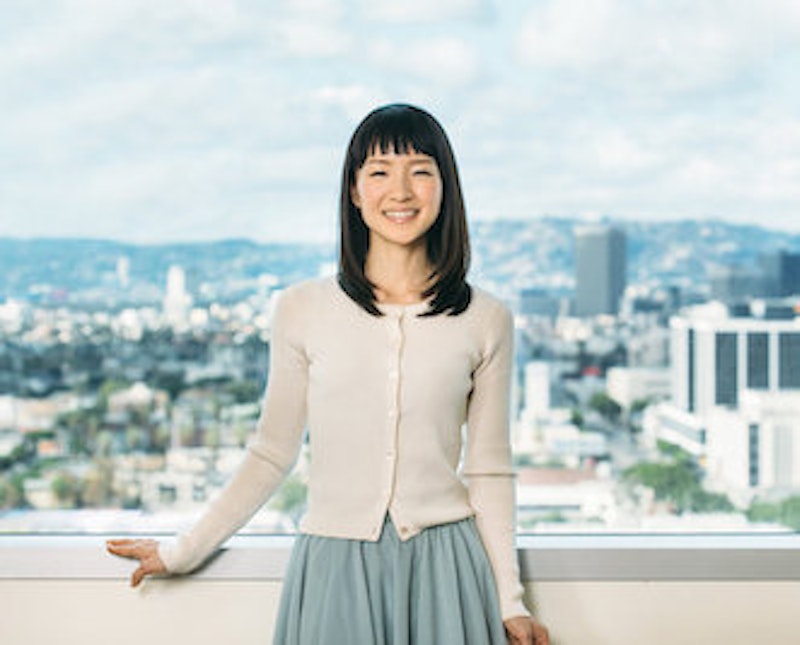The Japanese organizing consultant, Marie Kondo, has received a lot of attention lately. This is mostly because of the Netflix show, Tidying Up with Marie Kondo, which features episodes of Kondo helping people get out of their messes. The attention has mostly resulted in criticism, which has varied from serious to funny.
Judging from the show, I can see why some have reacted with anger or dismissal. Just like any program of this kind, (for example, Hoarders), it follows a simplistic formula: Kondo visits the home of a chosen couple or family, evaluates what’s wrong with it, briefly tells them what they need to do, brings some boxes and dividers for better organization, shows them how to fold laundry, and supposedly everyone lives happily ever after.
She acts a bit weird, like greeting the house, speaking to clothing, and asking whether items which people own “spark joy?” If this shirt or that pair of shoes doesn’t, then get rid of it! The willing participants invariably look at Kondo blankly and have semi-audible dialogues with themselves—“does it spark joy? What does she mean by that? I have no idea. I guess it doesn’t.” The encounters between Kondo and the participants are a bit awkward.
I laughed with the full might of my Slavic cynicism when I heard the words “spark” and “joy” in the same sentence. But I was still intrigued by this petite and gentle woman who’s also fierce in her tasks of helping others. The only way to make a fair assessment and judgment of Kondo’s tidying method (which she calls KonMari) is to read her book, The Life-Changing Magic of Tidying Up. I’m generally dismissive about any kind of quick fix that’s supposed to bring meditation and inspiration. And I’m suspicious of anything that even remotely smells like “Eastern wisdom for Western dummies” but Kondo’s book is anything but that.
The idea behind tidying and de-cluttering is simple: do you want your life to be better? What kind of environment are you living in? Most importantly, what kind of spiritual and mental state of mind are you experiencing in the current environment you’ve living in? For Kondo, to get your house in order is synonymous with getting your life in order. And she’s right. We rarely think about our relationship to an object or ask ourselves why do I own this? Or should I continue to own it? Or is this object really owning me?
Kondo’s method is not about discarding bags and bags of stuff, but finding the meaning of life in the midst of so many things (big or little, hidden or in plain sight) that we have. Kondo writes, “When we honestly confront the things we own, they evoke many emotions within us. Those feelings are real. Believe what your heart tells you when you ask, ‘Does this spark joy?’”
The notion of joy has many layers. Kondo never talks about transient happiness, a fleeting emotion that comes and goes. Rather, the joy she refers to means engaging in a dialog about what the authentic self is. Are the things we own simply masking the possibility of a more honest and creative self? Are we denying something deeper because we’re surrounded by meaningless trinkets?
As much as Kondo gives a lot of practical advice on how to tidy (the correct way to fold, finding an exact place for every item, minimizing storage, getting rid of overstock), the most important points in her book are about our emotional and spiritual states in relation to the objects. Kondo writes, “...when we really delve into the reasons for why we can’t let something go, there are only two: an attachment to the past or a fear for the future.” You might say that this is hardly a revelation and you’d be correct. But thinking about the flow of either our home or our life holistically is not something we generally do. Most of the time, we live in uncertainty and anticipation of many events in our lives and objects serve as something we can hold onto when we feel out of control. This is why what we own is directly related to how we want to live our lives. As Kondo writes, “Attachment to the past and fears concerning the future not only govern the way you select things you own but also represent the criteria by which you make choices in every aspect of your life, including your relationships with people and your job.”
As I was reading Kondo’s simple but true wisdom, I decided to put her method to the test. I brought out every article of clothing I owned and sifted through it. I owned clothes that were bought 20 years ago and haven’t been worn in probably almost the same amount of time. Lots of bags and boxes of clothes have been donated.
Finally, I think Kondo’s method of tidying is all about gratitude and mortality. If we’re grateful for the house we live in, or the clothes we wear, then this sense of gratitude will lead to a more balanced life and maybe we’ll have a bigger awareness of beauty.

